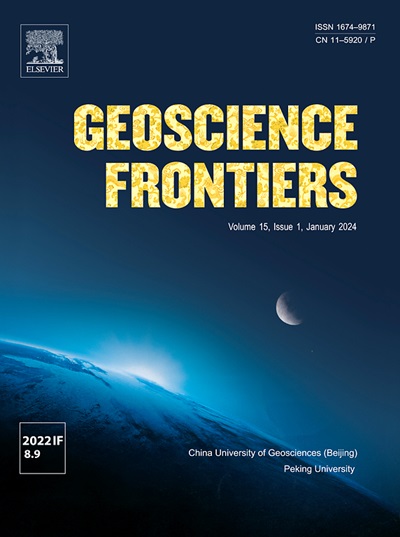Extreme gradient boosting with Shapley Additive Explanations for landslide susceptibility at slope unit and hydrological response unit scales
IF 8.9
1区 地球科学
Q1 GEOSCIENCES, MULTIDISCIPLINARY
引用次数: 0
Abstract
This study provides an in-depth comparative evaluation of landslide susceptibility using two distinct spatial units: and slope units (SUs) and hydrological response units (HRUs), within Goesan County, South Korea. Leveraging the capabilities of the extreme gradient boosting (XGB) algorithm combined with Shapley Additive Explanations (SHAP), this work assesses the precision and clarity with which each unit predicts areas vulnerable to landslides. SUs focus on the geomorphological features like ridges and valleys, focusing on slope stability and landslide triggers. Conversely, HRUs are established based on a variety of hydrological factors, including land cover, soil type and slope gradients, to encapsulate the dynamic water processes of the region. The methodological framework includes the systematic gathering, preparation and analysis of data, ranging from historical landslide occurrences to topographical and environmental variables like elevation, slope angle and land curvature etc. The XGB algorithm used to construct the Landslide Susceptibility Model (LSM) was combined with SHAP for model interpretation and the results were evaluated using Random Cross-validation (RCV) to ensure accuracy and reliability. To ensure optimal model performance, the XGB algorithm’s hyperparameters were tuned using Differential Evolution, considering multicollinearity-free variables. The results show that SU and HRU are effective for LSM, but their effectiveness varies depending on landscape characteristics. The XGB algorithm demonstrates strong predictive power and SHAP enhances model transparency of the influential variables involved. This work underscores the importance of selecting appropriate assessment units tailored to specific landscape characteristics for accurate LSM. The integration of advanced machine learning techniques with interpretative tools offers a robust framework for landslide susceptibility assessment, improving both predictive capabilities and model interpretability. Future research should integrate broader data sets and explore hybrid analytical models to strengthen the generalizability of these findings across varied geographical settings.

斜坡单元和水文响应单元尺度上滑坡敏感性的Shapley加性解释
本研究利用两个不同的空间单位:坡面单位(SUs)和水文响应单位(hru),对韩国槐山县的滑坡易感性进行了深入的比较评价。利用极端梯度增强(XGB)算法与Shapley加性解释(SHAP)相结合的能力,本工作评估了每个单元预测易受滑坡影响地区的精度和清晰度。重点研究山脊、山谷等地貌特征,重点研究边坡稳定性和滑坡成因。相反,hru是基于多种水文因素建立的,包括土地覆盖、土壤类型和坡度,以囊括该地区的动态水过程。方法框架包括系统地收集、准备和分析数据,从历史滑坡事件到地形和环境变量,如高程、坡度角和土地曲率等。将用于构建滑坡敏感性模型(LSM)的XGB算法与SHAP算法相结合进行模型解释,并使用随机交叉验证(RCV)对结果进行评估,以确保其准确性和可靠性。为了确保最佳的模型性能,XGB算法的超参数使用微分进化进行了调整,考虑了多重共线性无变量。结果表明,SU和HRU对LSM有效,但其效果因景观特征而异。XGB算法具有较强的预测能力,SHAP算法增强了所涉及影响变量的模型透明度。这项工作强调了为精确的LSM选择适合特定景观特征的适当评估单元的重要性。先进的机器学习技术与解释工具的集成为滑坡易感性评估提供了一个强大的框架,提高了预测能力和模型的可解释性。未来的研究应整合更广泛的数据集,并探索混合分析模型,以加强这些发现在不同地理环境中的普遍性。
本文章由计算机程序翻译,如有差异,请以英文原文为准。
求助全文
约1分钟内获得全文
求助全文
来源期刊

Geoscience frontiers
Earth and Planetary Sciences-General Earth and Planetary Sciences
CiteScore
17.80
自引率
3.40%
发文量
147
审稿时长
35 days
期刊介绍:
Geoscience Frontiers (GSF) is the Journal of China University of Geosciences (Beijing) and Peking University. It publishes peer-reviewed research articles and reviews in interdisciplinary fields of Earth and Planetary Sciences. GSF covers various research areas including petrology and geochemistry, lithospheric architecture and mantle dynamics, global tectonics, economic geology and fuel exploration, geophysics, stratigraphy and paleontology, environmental and engineering geology, astrogeology, and the nexus of resources-energy-emissions-climate under Sustainable Development Goals. The journal aims to bridge innovative, provocative, and challenging concepts and models in these fields, providing insights on correlations and evolution.
 求助内容:
求助内容: 应助结果提醒方式:
应助结果提醒方式:


